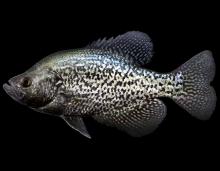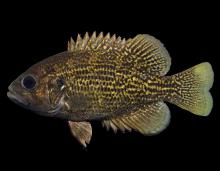Fishes
Media

Species Types
Scientific Name
Esox masquinongy
Description
The muskellunge is long and slender, with a mouth full of razor-sharp teeth. This big, nonnative pike is stocked in selected lakes in the Ozark region and near St. Louis.
Media

Species Types
Scientific Name
Esox lucius
Description
The largest pike native to Missouri, the northern pike can be more than 4 feet long and weigh more than 40 pounds. Missouri is on the southern edge of the range of this species. Because of its rarity here, it is of little importance as a game fish.
Media

Species Types
Scientific Name
Amia ocellicauda (formerly Amia calva)
Description
The eyetail bowfin is a stout-bodied, nearly cylindrical fish. It is most abundant in the Mississippi Lowlands, though it occurs along the entire length of the Mississippi River.
Media

Species Types
Scientific Name
Pomoxis annularis
Description
The white crappie, a popular panfish, has silver sides with 5 to 10 often faint vertical bars. The upper jaw reaches past the middle of the eye. It is more abundant and widespread than the black crappie.
Media

Species Types
Scientific Name
Pomoxis nigromaculatus
Description
The black crappie is a popular panfish. It is deep bodied and slab sided. The sides are silver with an irregular pattern of dark speckles. The upper jaw is long, reaching past the middle of the eye.
Media

Species Types
Scientific Name
Ambloplites rupestris
Description
The northern rock bass, or goggle-eye, is thicker than most other sunfish, with a large mouth and very large eyes. It occurs in northern Ozark streams, tributaries of the middle Mississippi, and a portion of the southwestern Ozarks; sometimes in Ozark reservoirs.
Media

Species Types
Scientific Name
Micropterus punctulatus
Description
The spotted bass inhabits permanent-flowing waters that are warmer and slightly more turbid than those where the smallmouth bass occurs. Note the form of its stripe and the length of its jaw.
Media

Species Types
Scientific Name
Morone saxatilis
Description
Primarily a marine species native to the Atlantic Coast of North America, the striped bass has been successfully stocked into several reservoirs in the United States. A silvery, elongated fish with prominent dark, horizontal stripes along the sides.
Media

Species Types
Scientific Name
Morone chrysops x M. saxatilis
Description
Hybrids between the striped bass and white bass are stocked by the MDC in select impoundments around the state. Also called "wipers," they attain a larger size than our native white bass.
Media

Species Types
Scientific Name
Lepomis microlophus
Description
The redear sunfish is deep and slab-sided, with a small mouth, with the upper jaw not reaching past the front of the eye. In natural waters, it is confined to the southern half of Missouri, but it is widely stocked in small reservoirs and ponds.
See Also


Media

Species Types
Scientific Name
Amphiuma tridactylum
Description
The three-toed amphiuma is an eel-like, completely aquatic salamander. It has very small forelimbs and hind limbs, each with three tiny toes. In Missouri it’s found only in the Bootheel region.
Media

Species Types
Scientific Name
Siren intermedia nettingi
Description
The western lesser siren is an eel-like, aquatic salamander with external gills, small eyes, small forelimbs with four toes, and no hind limbs. In Missouri, it’s found mostly in the Bootheel and northward in counties near the Mississippi River.
About Fishes in Missouri
Missouri has more than 200 kinds of fish, more than are found in most neighboring states. Fishes live in water, breathe with gills, and have fins instead of legs. Most are covered with scales. Most fish in Missouri “look” like fish and could never be confused with anything else. True, lampreys and eels have snakelike bodies — but they also have fins and smooth, slimy skin, which snakes do not.





















